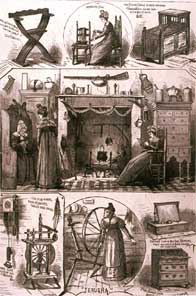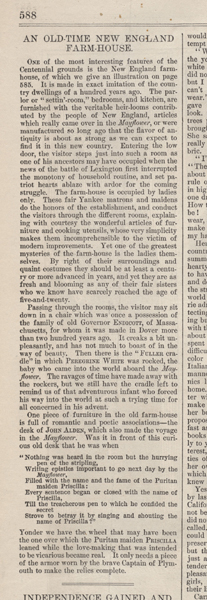
(Illustration of the "New England Kitchen" from
Harper's Weekly, July 17, 1876. Click on this thumbnail
image to see the full-sized version in the Slide Carousel)
|

("Old-Time New England Farm-House" article from
Harper's Weekly, July 17, 1876. Click on this thumbnail
image to see a larger version in the Slide Carousel)
|
AN OLD-TIME
NEW ENGLAND FARM-HOUSE
(transcription of Harper's Illustrated article, p.
588)
One of the most interesting features of the Centennial grounds
is the New England farmhouse, of which we give an illustration
on page 585. It is made in exact imitation of the country
dwellings of a hundred years ago. The parlor or "settin'-room,"
bedrooms, and kitchen, are furnished with the veritable heir-looms
contributed by the people of New England, articles which really
came over in the Mayflower, or were manufactured
so long ago that the flavor of antiquity is about as strong
as we can expect to find it in this new country. Entering
the low door, the visitor steps just into such a room as one
of his ancestors may have occupied when the news of the battle
of Lexington first interrupted the monotony of household routine,
and set patriot hearts ablaze with ardor for the coming struggle.
The farm-house is occupied by ladies only. These fair Yankee
matrons and maidens do the honors of the establishment, and
conduct the visitors through the different rooms, explaining
with courtesy the wonderful articles of furniture and cooking
utensils, whose very simplicity makes them incomprehensible
to the victim of modern improvements. Yet one of the greatest
mysteries of the farm-house is the ladies themselves. By right
of their surroundings and quaint costumes they should be at
least a century or more advanced in years, and yet they are
as fresh and blooming as any of their fair sisters who we
know have scarcely reached the age of five-and-twenty.
Passing through the rooms, the visitor may sit down in a
chair which was once a possession of the family of old Governor
ENDICOTT, of Massachusetts, for whom it was made in Dover
more than two hundred years ago. It creaks a bit unpleasantly,
and has not much to boast of in the way of beauty. Then there
is the "FULLER cradle" in which PEREGRINE WHITE
was rocked, the baby who came into the world aboard the Mayflower.
The ravages of time have made away with the rockers, but we
still have the cradle left to remind us of that adventurous
infant who forced his way into the world at such a trying
time for all concerned in his advent.
One piece of furniture in the old farm-house is full of romantic
and poetic associations--the desk of JOHN ALDEN, which also
made the voyage in the Mayflower. Was it in front
of this curious old desk that he was when
"Nothing was heard in the room but the hurrying pen
of the stripling,
Writing epistles important to go next day by the Mayflower,
Filled with the name and the fame of the Puritan maiden
Priscilla:
Every sentence began or closed with the name of Priscilla,
Till the treacherous pen to which he confided the secret
Strove to betray it by singing and shouting the name of
Priscilla?"
Yonder we have the wheel that may have been the one over
which the Puritan maiden PRISCILLA leaned while the love-making
that was intended to be vicarious became real. It only needs
a piece of the armor worn by the brave Captain of Plymouth
to make the relics complete. |
|

